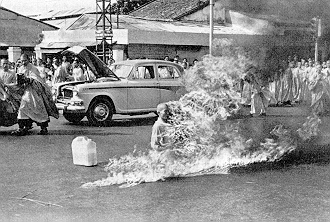
June 11, 1963, in Saigon, Vietnam, a Buddhist monk, Thich QuangDuc immolated himself in a busy intersection to protest religiousrepression by the South Vietnamese government under Ngo DinhDiem.
Representing Vietnamese "Self-Immolations"
from Russell T. McCutcheon, Manufacturing Religion,excerpted at http://www.buddhismtoday.com/english/vietnam/figure/003-htQuangduc.htm
"The often-occluded relations among power,imperial politics, and the specific portrayals of religious issues isperhaps no more apparent than in the case of the interpretationsAmerican media and intellectuals gave to the much-publicized actionsof several Vietnamese Buddhists who, beginning in mid-June of 1963,died by publicly setting themselves on fire. The first of thesedeaths occurred at a busy downtown intersection in Saigon, on 11 June1963, and was widely reported in American newspapers the followingday, although the New York Times, along with many other newspapers,declined to print Malcolm Browne's famous, or rather infamous,photograph of the lone monk burning (Moeller 1989: 404). The monk,seventy-three-year-old Thich Quang Duc, sat at a busy downtownintersection and had gasoline poured over him by two fellow monks. Asa large crowd of Buddhists and reporters watched, he lit a match and,over the course of a few moments, burned to death while he remainedseated in the lotus position. In the words of' David Halberstam, whowas at that time filing daily reports on the war with the New YorkTimes,
I was to see that sight again, but once was enough. Flames were coming from a human being; his body was slowly withering and shriveling up, his head blackening and charring. In the air was the smell of burning flesh; human beings burn surprisingly quickly. Behind me I could hear the sobbing of the Vietnamese who were now gathering. I was too shocked to cry, too confused to take notes or ask questions, too bewildered to even think.... As he burned he never moved a muscle, never uttered a sound, his outward composure in sharp contrast to the wailing people around him. (1965: 211)
After his funeral, where his remains were finallyreduced to ashes, Quang Duc's heart, which had not burned, wasretrieved, enshrined, and treated as a sacred relic (Schecter 1967:179)."
